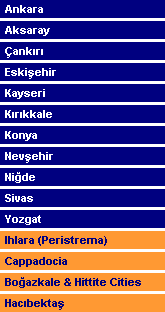| Eskisehir... |
|
Eskisehir is one of the oldest settlements (3500 BC) in this region. It was founded in the 1st millenium BC by
the Phrygians. The Porsuk River and its banks have been a proper foundation place. The city is of interest with the
museums; the Archaeological Museum which houses the Phrygian objects and sculptures; the Ottoman House Museum which is a
very fine example of the 19th century domestic architecture has the local ethnographical items. There are three
significant tombs around Eskisehir (belongs to the Central Anatolia of Republic of Türkiye). These are Sheik Edibali Tomb,
The Kumbet Baba Tomb, and The Cupola of Alemsah. Phrygian Valley, The Falcon Fortress, The Unfinished Monument, and the
Gerdek Rock are the other historical sites to visit. In Eskisehir you will frequently see items made of meerschaum stone
since this is the place where it originates. You will see the best meerschaum stone works at the Meerschaum Museum, The
Rug and Seyitgazi Museums have many samples of different kinds of kilims and hand-knit socks and stockings. In Eskisehir
there is opportunity to have good time at Sakaryabasi where there is a spring lake and fresh fish restaurants. Outside
Eskisehir is Sivrihisar (Justinianopolis) full of typical Ottoman houses and famous for its kilims. Seyit Battal Gazi
(Nakoleia) is 45 km south of Eskisehir. The mosque complex on the hill was built to pay homage to the Islamic hero Seyit
Battal. The Yunus Emre Village is the burial place of the world famous great poet of the 13th century, Yunus
Emre. There is a commemorative tomb built for him as well as a museum, and celebrations are held here every May. "Birth
Festivities" which are dedicated to Nasreddin Hoca, a humor master and public philosopher, is organized in Eskisehir
every year in the last week of June. 117 km from Ankara, on the Eskisehir road and 16 km to the right you will find the
Phrygian city Pessinus, its contemporary name Ballihisar. There you will see the Temple of Cybele -the mother goddess-, and
an open-air museum housing interesting sculptures found in this ancient Phrygian cult center, which was built in the
10th century BC. One of the most important settlement centers of the Phrygians, between the 8th and
6th centuries BC, was Midas, situated 66 kms south of Eskisehir. At this place of distant past, stands the
ancient city with an acropolis overlooking the lower land. On its northwestern side, are two open-air cult temples, carved
into the rock, and the most interesting sight in the area.
|
|

|


 222...
222...
 26...
26...
 706,009...
706,009...
 13,652...
13,652...
 30 E 32 - 39 N 46...
30 E 32 - 39 N 46...




